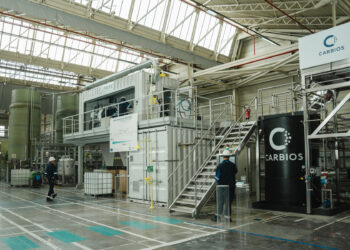It’s no secret that China is a leader in international world trade. For years, the country has been a major importer of many types of foreign goods, including timber, dairy products, and petrochemicals. China is also the world’s largest importer of waste. Last year, Chinese manufacturers and recyclers imported 7.3 million metric tons of waste plastics (valued at $3.7 billion), accounting for 56 percent of world imports in that category. It also took in more than half of the world’s exports of waste paper.
But a recent announcement by the Chinese government may soon change all of that. On July 18, China notified the World Trade Organization that it would ban imports of 24 categories of solid waste by the end of 2017, as part of its campaign against yang laji or “foreign garbage.” The proposed ban applies to several plastic resins (including PET, PE, PVC, PS, and “other” plastics), textiles, unsorted mixed paper, and other materials. While there is still a lot of ambiguity surrounding the exact specifications of what will be banned, one thing is for certain: China will be accepting a lot less material.
Some would argue that the ban should come as no surprise, as it is not the first time China has gotten strict on waste imports. China’s Green Fence initiative in 2013 imposed quality restrictions on imported recyclables and the more recent National Sword campaign, aimed at cracking down on illegal imports, has increased inspection and enforcement activity. Both policies have caused a great deal of disruption in the global recycling industry, and have prevented hundreds of containers full of foreign waste from entering the country.
Although in some ways China’s latest announcement could be seen as a simple extension of its previous efforts, there are some important differences. Green Fence and National Sword focused mostly on quality concerns and smuggling, whereas the import ban appears to be driven more by environmental and human health concerns and an effort to increase domestic collection and recycling to 350 million tons by 2020 (a 42 percent increase over 2015 levels). To attain that goal, imports of solid waste that can be replaced with domestic resources will be phased out starting in 2019. Another difference is that whereas Operation Green Fence set a limit of 1.5 percent maximum contamination in each bale, China’s latest initiative bans several types of recovered material outright.
Predicting the impacts
As the ban looms, the big question is what does this mean for the global recycling industry? While some predict that the impacts will be more severe than others, almost everybody seems to agree that big changes are coming, and that impacts will be felt both in China as well as abroad.
Aside from disrupting billions of dollars in trade, many worry that much of the waste that China imports annually—especially the lower-quality material—will have nowhere to go, and therefore be sent to landfills or incineration. After all, this was one result of China’s Green Fence policy. When China stopped accepting plastics Nos. 1-7, U.S. recycling centers that once accepted scrap plastic for recycling were forced to send it to disposal.
The lack of domestic infrastructure in many European and North American markets could also mean that some companies will send their exports to other markets, such as Southeast Asia, the Middle East, and Latin America, among others. According to the Institute of Scrap Recycling Industries (ISRI), current growth markets for paper include Mexico, Vietnam, Canada, and the Netherlands. India and Thailand have seen increases too.
To fill the demand gap left by its import restrictions, China may decide to use more primary raw materials to manufacture new products, which could potentially increase commodity prices. Copper prices, for example, hit two-year highs following the news of a potential ban on some imports of copper scrap, from the end of 2018. With regards to mixed paper, some predict that prices could plummet since all of the mixed paper accepted in residential recycling programs will have nowhere to go. Ultimately, the impacts on the recycled fiber market will depend on how tightly China defines “unsorted” paper. At the same time, prices of old corrugated cardboard (OCC) could see an increase if Chinese paper mills are suddenly cut off from some types of mixed paper, since they might decide to use more OCC in its place. OCC prices have already reached record levels, and these prices could be pushed higher again if Chinese demand continues to rise.
The ban could also have a ripple impact on municipalities that operate single-stream recycling programs. A major side effect of these programs is high contamination levels and reduced material quality. While some cities may be willing to invest in enhanced sorting and recycling facilities, many will not. As a result, some municipalities may cut back on their list of accepted materials, which will have an impact on recycling access. For some materials, this could mean that disposal is the only option.
This is already happening in Madison, Wisc., where the city’s Streets Division recently suspended the collection of rigid plastics until a new market becomes available. Recycling facilities around the greater Portland, Ore. region have also narrowed the types of plastic they accept. Far West Recycling, for example, announced last week that it is no longer accepting plastic bags and other film plastic; rigid plastics; or most mixed plastics.
Even more pressure on processing
The greatest impact of all will likely be felt by material recycling facility (MRF) operators that have not invested in upgrading their technology, such as optical sorting equipment. During the first six months of the Green Fence campaign, it was estimated that customs officials rejected 800,000-plus metric tons of recyclables at Chinese ports, with significant costs in terms of shipping, lost revenue and disposal charges. Within days of the policy coming into effect, the race was on to improve the quality of recyclables in North America and Europe to make sure China’s doors stayed open. In the U.S., material processors quickly modified their lines and added quality control measures, adding extra staff and machinery to improve the sorting of waste prepared for export. But not everyone welcomed the regulations with such open arms; while some recyclers turned to alternative markets, many other entities went completely out of business.
It is true that working to enforce cleaner streams comes at a cost, not only for MRFs but also for waste and recycling haulers. Investing in new and upgraded facilities increases the cost of collecting and processing recyclables, and these additional costs are passed along to municipalities and taxpayers who will need to pay more to get rid of their recyclables. Producers, in those countries, states or provinces which help finance recycling will also likely see their costs rise as a key market is cut off.
However, while many see China’s upcoming imports ban as a disaster for Western countries, others look at it as an opportunity.
For one, this policy will be beneficial for recyclers who “play by the rules” and who have invested in pollution control and other technologies to make their recyclables clean, allowing them to operate at a more equal and fair-cost level. Because the ban will create higher demand for higher quality recyclables, it may also open up new channels for manufacturers for direct access to recycled content, which can have a significant impact on reducing their carbon footprint.
The market action may also incentivize some countries to implement more targeted collection systems, such as deposit-return and other direct take-back systems, which are proven to produce streams of high quality materials for recycling.
Beyond improving quality, a ban by China on scrap paper and plastic could be the golden opportunity to strengthen the domestic recycling industry, in both North America and Europe. Consider, for example, a recent bill (the Zero Waste Development and Expansion Act) introduced in the U.S. Congress by Rep. Keith Ellison, D-Minn., that would invest $100 million in recycling facilities.
The Closed Loop Fund is another example of what is possible, and of investments that are already being made in domestic recycling infrastructure. Launched in 2014 – one year after Green Fence took effect – the Closed Loop Fund provides cities access to the capital required to finance comprehensive recycling programs to help advance the circular economy. In 2016 alone, the fund provided nearly $25 million to 11 projects, five of which involved sorting.
The announcement from China is also an important message to the European Union as stakeholders there negotiate the specifics on the legislative amendment to existing waste and packaging directives. China’s actions to reduce waste imports and improve domestic collection and recycling is consistent with the EU’s “ambitious” new recycling targets as well as a proper revision of the recycling point-of-measurement and calculation methodology – one which excludes contamination at all soring stages of the cycle, right through to final recycling.
The writing on the wall
Regardless of the impacts, we seem to have reached a tipping point. China has made it clear that it no longer wants to be the world’s garbage dump, which means that big changes are on the way, not only for recycling businesses, but also for manufacturers and consumers who make and use packaging and products.
China’s plans may ultimately lead to a re-thinking around existing collection systems. The result could be redesigning for more efficiency and making the ones that work, work even better.
Clarissa Morawski is based in Spain and serves as the managing director of the Reloop Platform, which brings together industry, government and non-governmental organizations in Europe to form a network for advances in policy that create system conditions for circularity across the European economy. She is also principal of Canada-based CM Consulting Inc. She can be contacted at [email protected].
The views and opinions expressed are those of the author and do not imply endorsement by Resource Recycling, Inc. If you have a subject you wish to cover in an op-ed, please send a short proposal to [email protected] for consideration.



























